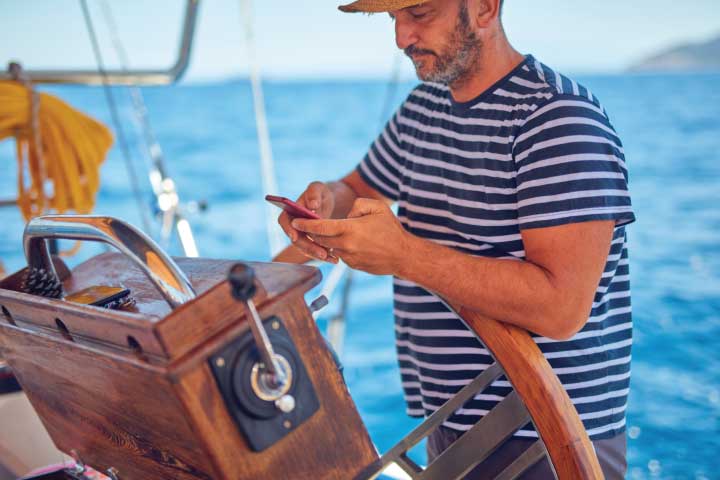What Information Should Be Included on a Float Plan?
Last Updated on August 16, 2022 by Boatsetter Team
Just like a pilot files a flight plan, boaters file float plans. If you’re new to boating, a float plan may sound unfamiliar, but it’s essential and easy to make.
A float plan is basically an overview of your boat outing plus additional information about the boat and crew that may expedite search-and-rescue (SAR) operations in an emergency.
Own a Boat? Learn How to Offset the Cost of Ownership by Listing on Boatsetter
Creating a Float Plan Template
Making your own float plan template for repeat use is simple. Start by creating a written document detailing where you’ll go, midway stops, and when you plan to depart and arrive. If you fail to reach a planned mid-point or the destination, SAR operations may be activated.
A float plan should contain the following information:
- Boat name
- Type of boat
- Boat brand
- Size of boat
- Color of boat
- Boat identification number (i.e. USCG documentation number)
For example: “Vessel Starlight, is a white 40-foot Beneteau sailboat with a blue stripe and a navy blue Bimini.”

Add to your plan a description of you, your crew, and your captain:
- Number of people aboard
- Their ages
- Their names
- Their genders
- Any medical conditions or disabilities
Also, mentioning your captain’s experience level might be a good thing to include.
If you launched the boat at a ramp, make sure to include the ramp location and your tow vehicle license plate.
Finally, add any safety gear or communications equipment, such as:
- EPIRB
- Life raft
- Flares
- VHF
- Long-range radios
- Cell or satellite phone numbers.

Make sure to include multiple ways to reach you! Check out our Boat Safety Equipment Checklist for additional items you should always keep onboard.
What is the purpose of filing a float plan?
There are some risks associated with boating if proper boating etiquette and safety protocols are not followed—such as on-water collisions, mechanical breakdowns, water ingress (sinking), fires, medical emergencies, rough weather, malfunctioning, etc. In the case of an emergency like the ones described above, a float plan will help authorities such as the U.S. Coast Guard or a local on-water towing agency find you quickly.
You can file a float plan regardless of your trip length or boat size, whether going offshore on a large sailboat or down a river in a kayak. It adds a safety factor and also peace of mind for everyone.
How do you file a float plan?
A float plan doesn’t need to be formal—just a list containing the information above, letting someone know where you’re going and when you’re returning.
- Leave your float plan with a responsible party who will not be on the boat. This could be a friend, neighbor, family member, or marina official, but it should be someone you trust to contact the Coast Guard if you go missing.
- You can also file a float plan with your on-water towing agency, such as Sea Tow or TowBoatUS, or even with your local U.S. Coast Guard Auxiliary branch.
- Ideally, file a float plan a few days before departure.
- Should your plans change, you must contact your responsible party and advise of any changes due to weather, mechanical issues, or a cancellation.
An unnecessary SAR operation is a costly waste of resources. This is why we advise all boaters never to leave a float plan open—always close out and let your contact know you’ve arrived.
Setting a check-in with your party

Indicate where and when you intend to check in with your responsible party. For example, on a multi-day trip, you may set your check-in every evening by 6:00 pm via cell phone or VHF radio.
Your responsible party should try to reach you if you don’t check in on time. In case you become unreachable, SAR operations may be activated. If you don’t plan to check in along the way, state that on the float plan so you don’t create unnecessary worry.
Float Plans Save Lives
It may seem silly to file a float plan if you’re going to party at a cove or pontooning on a small lake, and you may never need to use it, but as the old adage goes: better safe than sorry.
Want to know what to do if you run out of gas while boating? Read about it here.
Don’t let your boat sit idly by. List it with us to earn $20K on avg.

Zuzana Prochazka is an award-winning freelance journalist and photographer with regular contributions to more than a dozen sailing and powerboating magazines and online publications including Southern Boating, SEA, Latitudes & Attitudes and SAIL. She is SAIL magazines Charter Editor and the Executive Director of Boating Writers International. Zuzana serves as judge for SAIL’s Best Boats awards and for Europe’s Best of Boats in Berlin.
A USCG 100 Ton Master, Zuzana founded and manages a flotilla charter organization called Zescapes that takes guests adventure sailing at destinations worldwide.
Zuzana has lived in Europe, Africa and the United States and has traveled extensively in South America, the islands of the South Pacific and Mexico.










